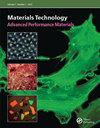激光诱导医用不锈钢波纹平面内弯曲及其与生物功能的关系
IF 3.7
4区 材料科学
Q3 MATERIALS SCIENCE, MULTIDISCIPLINARY
引用次数: 4
摘要
系统研究了生物医用不锈钢在空气和水中激光诱导的周期性表面结构(LIPSS)。在激光扫描的各个轨迹中,LIPSS在纹波中心附近呈现平面内曲线,且曲线方向与激光扫描方向相反。LIPSS的集体面内弯曲是单列脉冲激光加工的一个未知特征,这是由于激光烧蚀和再沉积的累积效应,它改变了表面散射波与入射激光束之间的干涉。介质、扫描速度和激光通量的组合表明,降低扫描速度可以增加粗糙度。在低扫描速度和高激光功率的流动水中产生波纹有利于生物材料的亲水性。表面亲水性高,接触角低至47.00±9.35°。研究结果为LIPSS的形成和生物医学应用提供了新的见解。本文章由计算机程序翻译,如有差异,请以英文原文为准。
Laser-induced in-plane curving of ripples on biomedical stainless steel and their relationship to biological functions
ABSTRACT Laser-induced periodic surface structures (LIPSS) on biomedical stainless steel in air and water were systematically studied. The LIPSS exhibit in-plane curves near the ripple centres in the individual tracks of laser scan and the curving was opposite to the laser scan direction. The collective in-plane curving of LIPSS, a hitherto unknown feature for single train pulsed laser processing, is attributed to the accumulative effect of laser ablation and redeposition, which modifies the interference between the surface scattered wave and the incident laser beam. Combinations of media, scan-speed, and laser fluence, showed that the roughness can be increased by slowing the scan-speed. Ripples fabricated in the flowing water with slow scan-speed and high laser power are helpful for the hydrophilicity of biomaterials. A contact angle as low as 47.00 ± 9.35° is obtained towards high surface hydrophilicity. The results provide new insights on LIPSS about their formation and biomedical applications.
求助全文
通过发布文献求助,成功后即可免费获取论文全文。
去求助
来源期刊

Materials Technology
工程技术-材料科学:综合
CiteScore
6.00
自引率
9.70%
发文量
105
审稿时长
8.7 months
期刊介绍:
Materials Technology: Advanced Performance Materials provides an international medium for the communication of progress in the field of functional materials (advanced materials in which composition, structure and surface are functionalised to confer specific, applications-oriented properties). The focus is on materials for biomedical, electronic, photonic and energy applications. Contributions should address the physical, chemical, or engineering sciences that underpin the design and application of these materials. The scientific and engineering aspects may include processing and structural characterisation from the micro- to nanoscale to achieve specific functionality.
 求助内容:
求助内容: 应助结果提醒方式:
应助结果提醒方式:


